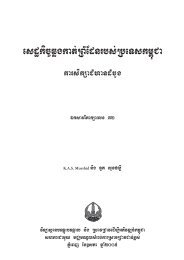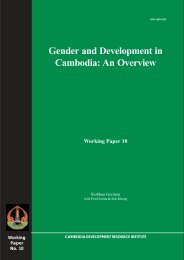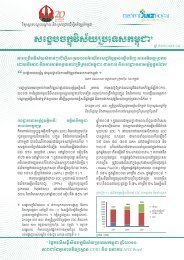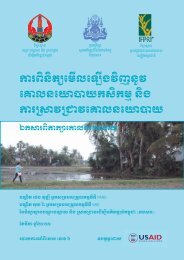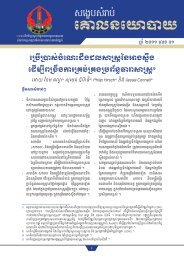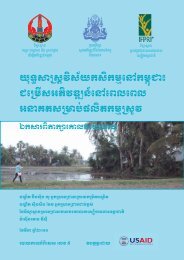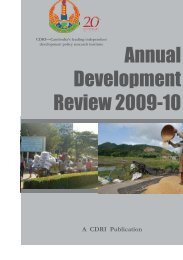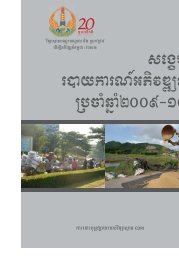62) decentralised governance of irrigation water in cambodia - CDRI
62) decentralised governance of irrigation water in cambodia - CDRI
62) decentralised governance of irrigation water in cambodia - CDRI
You also want an ePaper? Increase the reach of your titles
YUMPU automatically turns print PDFs into web optimized ePapers that Google loves.
O&M issues concern<strong>in</strong>g <strong>water</strong> usage as well as local practical solutions and conflict resolution<br />
mechanisms. Some <strong>of</strong> the questions posed <strong>in</strong> the FGD were asked aga<strong>in</strong> <strong>in</strong> farmer <strong>in</strong>terviews <strong>in</strong><br />
order to validate the previous responses. The questionnaires designed for <strong>in</strong>terview<strong>in</strong>g farmer<br />
were used flexibly – that is, responses from the first FGDs and KI <strong>in</strong>terviews were used to<br />
direct the farmer <strong>in</strong>terviews where necessary.<br />
Field observations were taken alongside the farmer <strong>in</strong>terviews to get more <strong>of</strong> an idea<br />
about present <strong>irrigation</strong> management, <strong>water</strong> allocation practice, the physical structure <strong>of</strong><br />
the <strong>irrigation</strong> systems, and other <strong>water</strong> related issues. Importantly, observ<strong>in</strong>g the location <strong>of</strong><br />
the <strong>in</strong>terviewees’ rice paddy with<strong>in</strong> the <strong>irrigation</strong> system contextualised their responses and<br />
perceptions <strong>of</strong> the issues. The field observations provided better opportunity for the team to<br />
access and collect as much data and <strong>in</strong>formation as possible and to witness first-hand how<br />
and where <strong>water</strong> related issues have occurred <strong>in</strong> specific geographical conditions. Dur<strong>in</strong>g the<br />
discussion, maps produced by the research team were used as a support tool so that farmers<br />
could po<strong>in</strong>t out the exact locations <strong>of</strong> critical issues and potential locations for <strong>in</strong>frastructural<br />
solutions e.g., where a canal system could be built to solve <strong>water</strong> shortage issues or to improve<br />
<strong>water</strong> allocation and management <strong>in</strong> the area.<br />
3.5 Prov<strong>in</strong>cial Workshops<br />
A number <strong>of</strong> prov<strong>in</strong>cial workshops were held <strong>in</strong> Kampong Chhnang, Kampong Thom and<br />
Pursat prov<strong>in</strong>ces to collect data and <strong>in</strong>formation and to seek further advice that could contribute<br />
to better <strong>irrigation</strong> management and <strong>in</strong>creased agricultural production. The workshop provided<br />
a good opportunity for all stakeholders to discuss:<br />
1.<br />
2.<br />
3.<br />
4.<br />
A common vision<br />
Strategies for improv<strong>in</strong>g <strong>irrigation</strong> systems<br />
Key issues and potential solutions<br />
Stakeholders’ responsibilities <strong>in</strong> <strong>irrigation</strong> management<br />
5. Appropriate advice on important methodologies to be established by the team to<br />
fruitfully participate <strong>in</strong> the development <strong>of</strong> guidel<strong>in</strong>es for <strong>water</strong> allocation, and the<br />
best practices to improve <strong>irrigation</strong> management and <strong>water</strong> <strong>governance</strong> at local level.<br />
3.6 Data Triangulation<br />
Data from the literature review, farmer and KI <strong>in</strong>terviews, FGDs and workshops were<br />
cross-checked (through communication with stakeholders) and compiled. This “triangulation”<br />
method ensures the reliability <strong>of</strong> the data and thus data analysis is more conv<strong>in</strong>c<strong>in</strong>g.<br />
In-depth data analysis was undertaken to: 1) identify root causes <strong>of</strong> the <strong>water</strong> issues and<br />
gaps or <strong>in</strong>consistencies between policies and farmer practices, and to seek proper resolutions<br />
from stakeholders; 2) have a clear understand<strong>in</strong>g <strong>of</strong> the specific conditions <strong>in</strong> Cambodia that<br />
may help <strong>governance</strong> <strong>in</strong>itiatives such as PIMD and IMT, and to help FWUCs operate effectively;<br />
and 3) assist public policy decision-makers <strong>in</strong> compar<strong>in</strong>g and evaluat<strong>in</strong>g policy alternatives.<br />
<strong>CDRI</strong> Work<strong>in</strong>g Paper Series No. <strong>62</strong><br />
11



